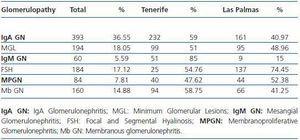Dear Editor,
In recent years, knowledge of the physiology of the renal glomerular basement membrane and the podocyte has advanced considerably. The discovery of several genes producing proteins that are expressed, specially in the podocyte, has led to the discovery of the causes, when these proteins are abnormal, of several entities of genetic origin which progress with nephritic syndrome and, in some cases, with focal and segmental hyalinosis.1,2
In 1987, the Canaries Society of Nephrology (Sociedad Canaria de Nefrología) created a Register of renal biopsies, which has been maintained without interruption to this day. During its 21 years of existence, the register has collected reports on 3379 renal biopsies, 1319 of which correspond to cases of primary glomerulonephritis (39%.) Table 1 shows the most common diagnoses.
As the number of cases included in the register increased, regional differences were noted in the prevalence of certain glomerulopathies, despite the fact that the population of each of the two provinces on the Canary Islands is similar (table 1.) The greater frequency of focal and segmental hyalinosis in the university hospitals in the province of Las Palmas (Doctor Negrín, Insular and Mother and Child hospitals) is noteworthy in comparison with those of the province of Santa Cruz de Tenerife (University hospital and Nuestra Señora de Candelaria.) These differences were even noted when the sample was divided into two periods of a similar duration. However, diagnoses of IgM mesangial glomerulonephritis are more common in the hospitals of Tenerife (table 1.) Differences, although less significant, have also been observed in the prevalence of membranous and IgA mesangial glomerulonephritis, which are more common in the hospitals of Tenerife.
The regional differences observed must be related to a different genetic load in the populations of each province. Historians and archaeologists believe that the first natives of the island arrived at different times from North Africa.
The discovery of the Zanata3 stone and recent studies carried out using molecular biology techniques4-5 have shown Berber origins in some of the arrivals. Despite having the same origins, it is known that the settlers of the seven main Canary Islands lived independently and separate from one another, since they did not know how to sail.6 This led to a certain degree of consanguinity between the inhabitants of each of the islands. In 1402, Juan de Bethencourt and Gadifer de la Salle, Normandy soldiers representing the King of Castile, began the conquest of the islands, starting with Lanzarote.6 The last, La Palma, was conquered in 1496. Settlers came from different parts of the Iberian Peninsula, in particular, Castile and Andalusia.
After the conquest, the islands were populated with descendents of the natives (rather few) and the conquerors themselves, but also Jews from Portugal and the mainland,7 Sub-Saharan Africans8,9 and, later, natives of America9 and Europe fleeing religious wars.10 Despite the evident genetic diversity, there was without doubt a high rate of consanguinity, as has been recently proved, for example, in La Gomera. This demonstrated high rate of consanguinity was due to obvious geographic and social reasons (marriage between relatives so as to preserve families' wealth.) In fact, frequent contact between the inhabitants of the different islands has only become common in the last few decades.
It is therefore possible that there were different genetic concentrations on the different islands. This explains the diversity in the frequency of some glomerulopathies that are repeatedly seen year after year in the hospitals of the two Canary provinces. Our genetic theory is also supported by the difference in the prevalence of focal and segmental hyalinosis on other national registers. It has been written that the Chinese population accounts for only 6% of cases of glomerulopathies12 while in studies carried out in Italy and Holland, the frequency of these are 20.713 and 27.5%14 respectively.
We are currently starting to look for mutations in different genes that are expressed in the podocyte in patients with idiopathic nephritic syndrome on the Canary islands.15,16We hope that in time we will know the exact genetic reasons for having such significant differences in the prevalence of certain glomerulopathies in such a small geographical area such as the Canary Islands.
Table 1. Distribution of the main cases of glomerulopathies in the two provinces of the Canary Islands










